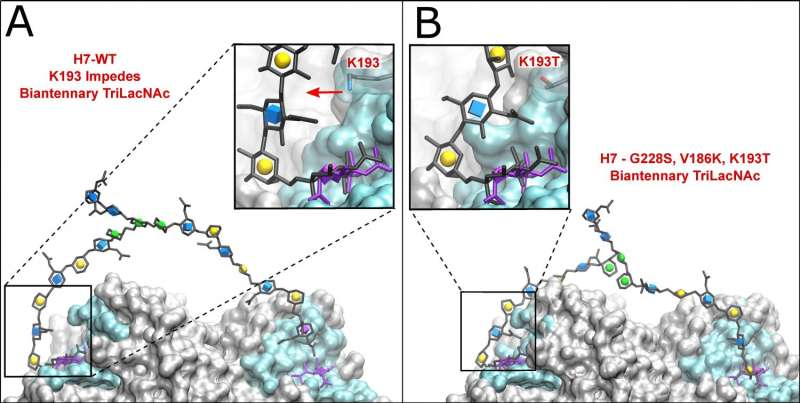Scientists ID mutations that could allow bird flu strain to spread among humans

An international team of scientists has identified several genetic mutations that, should they arise, could potentially allow the avian influenza strain H7N9 to spread between humans. The findings are published in PLOS Pathogens.
H7N9 is a strain of flu virus that normally infects birds but has spread to at least 779 humans in a number of outbreaks related to poultry markets. The virus is not currently capable of spreading sustainably from human to human, but scientists are concerned that it could potentially mutate into a form that can.
To investigate this possibility, James Paulson of The Scripps Research Institute, California, and colleagues analyzed mutations that could occur in H7N9's genome. They focused on a gene that codes for the H7 hemagglutanin, a protein found on the surface of flu viruses. This protein allows flu viruses to latch onto host cells.
Flu strains that circulate in avian viruses have different subtypes of hemagglutanin, called H1-H16. So far only three subtypes have been found in human flu viruses (H1, H2 and H3). Like other avian flu viruses, H7N9 has is specific for receptors on bird cells, but not receptors on human cells. However, a transition to human specificity could enable H7N9 to circulate among humans, just like other human flu strains that have caused pandemics in the past.
The research team used molecular modeling and knowledge of hemagglutanin's structure to identify mutations that would change the protein's amino acid sequence and cause a switch to human specificity. Then, they produced the hemagglutanin with different combinations of these mutations in an experimental cell line (testing the mutations in H7N9 viruses themselves could be dangerous).
The scientists harvested the mutant hemagglutanin proteins from the cells and tested how strongly they bound to human-type and bird-type receptors. Several forms with mutations in three amino acids bound far more strongly to human receptors; they had switched specificity from bird to human. These triple-mutant H7 hemagglutinins also successfully latched onto cells in samples of human trachea tissue.
Safety regulations prohibit introducing these mutations to actual H7N9 viruses, limiting scientists' ability to test their effects in animals. Nonetheless, the research team suggests that keeping an eye out for the development of these mutations in humans infected with H7N9 could help trigger a timely response to prevent potential spread.
More information: PLOS Pathogens (2017). DOI: 10.1371/journal.ppat.1006390



















